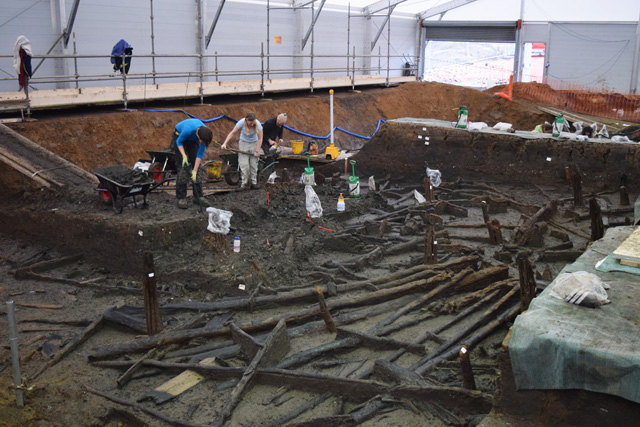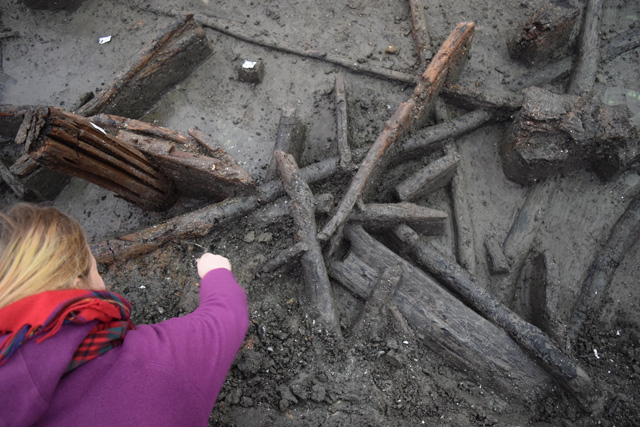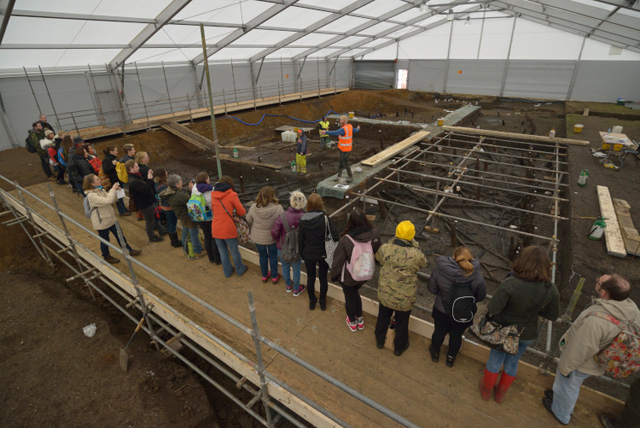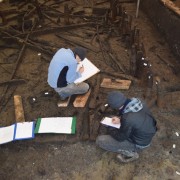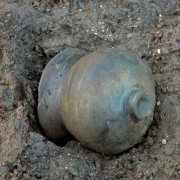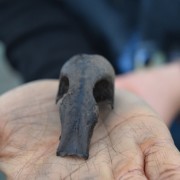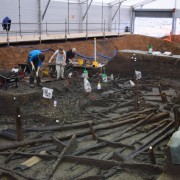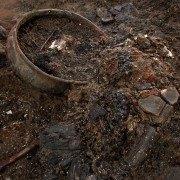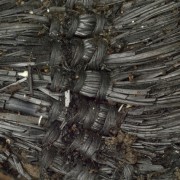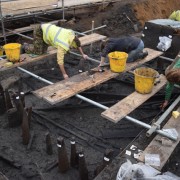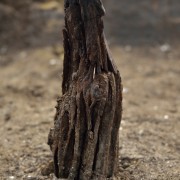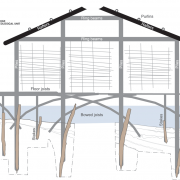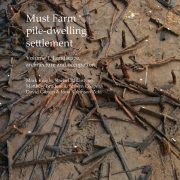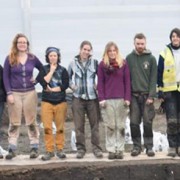Dig Diary 8: Understanding the Site
December 7, 2015
Planning for the Must Farm excavation
Preparing for an excavation is always an incredibly challenging proposition. It is very difficult to accurately predict what archaeology we will encounter, no matter how much is done to evaluate the site. From the moment the timber platform was first discovered, it was clear that the archaeology there was different from most standard sites. However, even after two evaluations it was hard to imagine exactly what could be waiting for us when we began to remove the overlying silts.
The 2006 excavations gave us a tiny glimpse into a large and complex site. From this small slice of the timber platform we had to try and understand it as a whole. It was necessary to try and predict what the timber platform’s function was, whether people lived there, how long it was used for and how important it was in the landscape amongst many other questions. Alongside this, there were more practical considerations. How long would it take to excavate? How dense would the material be? What would the preservation be like across the whole area? Given the very small size of the area opened during the evaluation, this was a very tough task.
Using a combination of our archaeological experience, comparisons with other sites, a series of specialist reports and knowledge of the location we created a detailed strategy for the excavation. Sometimes we could be fairly confident about our assumptions: we were fairly certain about the shape and location of the palisade uprights. However, a large portion of the strategy was based on educated calculations, such as the density of the finds and the preservation of the materials across the whole site.
It can’t be emphasised enough that having the ability to excavate the Must Farm timber platform as an open-area excavation is vital. Doing so allows us to fully appreciate the archaeology as we uncover it as a whole entity. This means we can look for patterns across areas of posts and wooden debris and see if there are any anomalies. It also gives us the most complete picture possible during the process of digging and recording, which gives us the best chance of interpreting the archaeology correctly. The platform excavation is not only about the depth of the preserved archaeology, it is also about being able to view its full contextual breadth.
Interpreting the Archaeology
One of the most important aspects of any archaeological excavation is that the interpretation and understanding of a site is not fixed. It is constantly evolving and changing to reflect the newest information we are gathering. This can range from new structural elements to the microscopic insects being analysed. Our initial understanding of the site is “blurry” but as we refine our knowledge, not only through excavation but artefactual and scientific analysis, it becomes more and more focused.
Already, our interpretation of the timber platform site is changing from our initial ideas. The term “platform” is now looking less-and-less likely to be accurate. As opposed to a single wooden structure it looks as though the site was a series of them, potentially a number of different dwellings. There are other tantalising elements emerging such as the possibility of an earlier timber walkway running through the site, equivalent in its scale to Flag Fen. Working on an excavation is a process of moving closer to a more accurate interpretation and putting together the pieces of the puzzle correctly.
We are fortunate enough to have lots of different people visiting the site, from archaeological and environmental specialists to local history groups and workers from the adjacent quarry. The diverse backgrounds and knowledge of these individuals is invaluable to us and can often lead us to consider ideas and interpretations we would never otherwise have considered.
A few weeks ago when the structural timbers first began to emerge, we had a quarry carpenter visit the site for a tour. As he was going around he spotted some large pieces of burnt debris and said that they reminded him of roof timbers. Only a day earlier, the project’s wood specialist had also identified the same timbers as likely being rafters. This sharing of knowledge is vital to us and helps us to constantly assess how we are understanding the archaeology that we are faced with.
Being able to view the archaeology in terms of both depth and breadth is such an important facet of this project and one which helps us to see the wider context of the material. Equally, having such a diverse team of specialists, as well as regular visitors, gives us a huge pool of knowledge to draw from to help us actually understand the site. We will make inaccurate assumptions but being able to correct and move forward towards more authentic interpretations is one of the elements that drive us as archaeologists.
We’re already able to understand new aspects of the timber platform and by the end of the project we’re going to be able to bring you more of its story. Even after the excavation stops there will still be huge amounts of latent detail that will be shaping and reshaping our understanding of this incredible archaeology. Analysis of insects, pollen, sediments, food residues, textiles, metalwork and so many more will always be refining how we interpret the site. Even though the digging may finish, the site will continue to play a huge part in comprehending later Fenland prehistory
Related stories
Dig Diary 11: The Importance of the Wood Record
January 4, 2016
Dig Diary 10: Looking Further Afield
December 21, 2015
Dig Diary 9: The Site and its Environment
December 14, 2015
Dig Diary 8: Understanding the Site
December 7, 2015
Dig Diary 7: What is the Timber Platform?
November 30, 2015
Dig Diary 6: Textiles
November 23, 2015
Dig Diary 5: Revealing the Remains of the Fire
November 16, 2015
Dig Diary 4: Asking the Right Questions
November 9, 2015
Learn more
About
The Must Farm pile-dwelling settlement was excavated by the Cambridge Archaeological Unit with funding from Historic England and Forterra.Publications
Read the Open Access publications the Must Farm pile-dwelling settlement: Volume 1. Landscape, architecture and occupation and Volume 2. Specialist reports.Post-Ex Diaries
Our work on-site has finished but lots more investigation is taking place as we study both the material and the evidence we recovered. ...read more
Discoveries
See some of the discoveries from the Must Farm pile-dwelling settlement.
Making Must Farm
Find out about our work with AncientCraft recreating Must Farm’s material.
FAQs
Further information on the Must Farm project.

